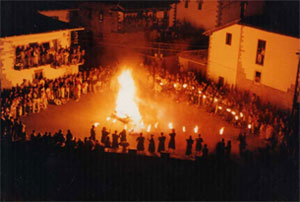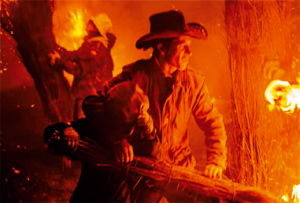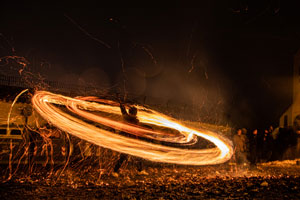The descendent of the Witch

The last week of August, the celebration of the patron saint festivities in honor of Saint Augustine begins. To commemorate this important date, the first day of opening to this event begins with the so-called The descendent of the Witch in the town of Vidangoz, in Navarra, Spain.
What is the origin of this tradition?
This picturesque tradition has its origin in the Pirienos region, in a town called Vidangoz. It is quite a remote place, which is also called the town of witches, like its inhabitants.
According to history, it all begins in medieval times, where a large part of the inhabitants had beliefs in mythical ancient legends, where women had great wisdom and were able to cure even the most terrible diseases with the use of miraculous plants.
From there the tradition of celebrating the Descent of the Witch is born as a way to venerate this event, considered as a true act of witchcraft.
What does the Descendent of Witch celebration consist of?

On the last day of August, just as midnight begins, the witch's descent begins. The whole town plunged into total darkness, begins to hear a mysterious and deafening music that interrupts the night.
In the distance, a lighted torch can be seen, which together with the loud sound coming from a horn, makes a witch appear carrying it in his hand, this picturesque character summons other witches to join him.
This is called the "Aquelarre", suddenly three columns of lighted torches appear that dance to the rhythm of the music. It is all the witches, who dressed completely in black and wearing hooded suits, climb to the top.
Once gathered there, surrounded by the fire of the torches, the descent begins towards the entrance of the town.
Who participates in this traditional festival?
In this magical traditional dance a troupe of witches participate, who united in a certain halo of mystery, begin their dance, but not before lighting the fire with one of the torches.
This ceremony is started by one of the witches. Suddenly his face is lit by fire, causing amazement and fear among the audience. The dance immediately begins with the rest of the witches and each of their movements gives the impression that they were possessed by some energy from another world.
How is the witch's descent closed?
To end this show, a witch riding a broom suddenly appears in the sky carrying two flares, one in front and one behind.It receives the name of "Maruxa" and its participation in this event is one of the most anticipated.
This causes a real adrenaline rush in the crowd, since the witch suddenly launches herself towards the public, achieving a hypnotizing effect on them, while continuing the dance to the rhythm of the music to which all the attendees finally join to tour that night all the streets of the town.
The festivity takes place over five days and every night "Maruxa" appears. The closing is done with the rise of the witch, who begins her flight and disappears in the sky until the next holidays.
Thus ends a celebration, with a town steeped in mystery and the spell of a tradition that each year attracts the attention of thousands of people.





